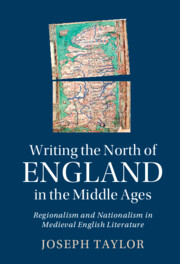 Writing the North of England in the Middle Ages
Writing the North of England in the Middle Ages Published online by Cambridge University Press: 08 December 2022
The book’s conclusion briefly examines the Northern Rebellion of 1569, a revolt centered again on the entanglement of centralization and religious reform with the South set against the North. This northern Catholic revolt proves a fitting culmination to the book because, here, we find the same convoluted dynamic of intimacy and revulsion, of derision and desire of the North of England evident in each chapter. The putting down of the revolt, the bloody and destructive retribution that followed by Elizabeth I’s government, recalls the “Harrying of the North” by William I exactly 500 years prior. But the aftermath of 1569 witnesses an emergent British identity form between England and Scotland, an identity afforded by the Northern Rebellion, that would drive England into the age of imperialism and, eventually, toward the Industrial Revolution from which so many critics claim the North–South divide originates. The chapter concludes by briefly pondering modern readings of a still-extant North–South divide in poetry, fiction, and film in order to illustrate just how essential North–South discourse, forged in the Middle Ages, continues to inform the modern rift.
To save this book to your Kindle, first ensure [email protected] is added to your Approved Personal Document E-mail List under your Personal Document Settings on the Manage Your Content and Devices page of your Amazon account. Then enter the ‘name’ part of your Kindle email address below. Find out more about saving to your Kindle.
Note you can select to save to either the @free.kindle.com or @kindle.com variations. ‘@free.kindle.com’ emails are free but can only be saved to your device when it is connected to wi-fi. ‘@kindle.com’ emails can be delivered even when you are not connected to wi-fi, but note that service fees apply.
Find out more about the Kindle Personal Document Service.
To save content items to your account, please confirm that you agree to abide by our usage policies. If this is the first time you use this feature, you will be asked to authorise Cambridge Core to connect with your account. Find out more about saving content to Dropbox.
To save content items to your account, please confirm that you agree to abide by our usage policies. If this is the first time you use this feature, you will be asked to authorise Cambridge Core to connect with your account. Find out more about saving content to Google Drive.